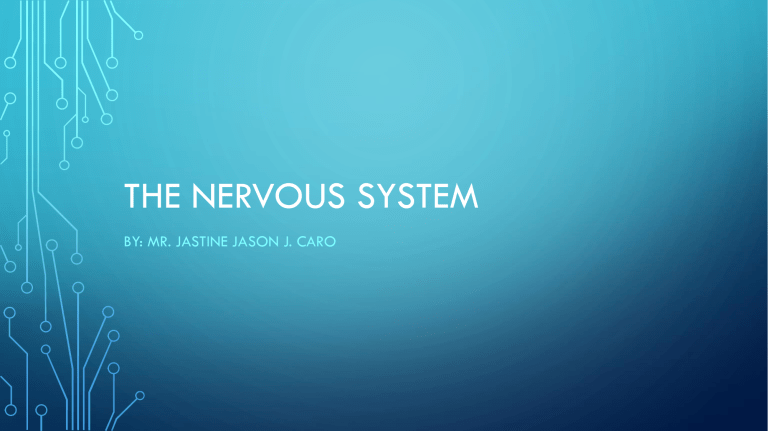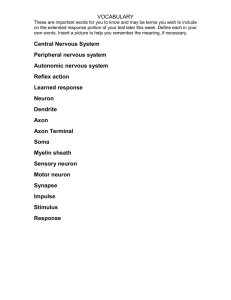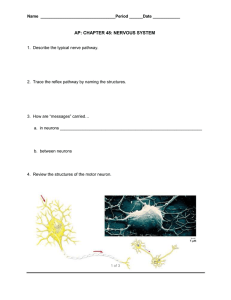Nervous System
advertisement

THE NERVOUS SYSTEM BY: MR. JASTINE JASON J. CARO FUNCTIONS • Controls and coordinate all the different parts of the body. • Controls responses involving emotions, reasons, and habitats. MAIN PARTS • Central Nervous System (CNS) – consist of the brain and the spinal cord. • Peripheral Nervous System (PNS) – consist of a network of nerves and sense organs. CENTRAL NERVOUS SYSTEM • It is the control center of the body. • It is protected by the skull and the vertebrae of the spinal column. • The brain and the spinal cord are covered by layers of connective tissues called meninges. PERIPHERAL NERVOUS SYSTEM • It consist of network of nerves connecting the CNS to the other parts of the body. • It carries messages between the CNS and the rest of the body. • It includes the cranial nerves, spinal nerves, and ganglia (contains nerve cell bodies). CRANIAL NERVES GANGLIA PERIPHERAL NERVOUS SYSTEM • The sensory division conducts impulses from the sense organs to the CNS. • The motor division conducts impulses from the CNS to the effectors (muscles or glands) of the body. MOTOR DIVISION (PNS) • It consists of the somatic nervous system and the autonomic nervous system. • The somatic nervous system innervates skeletal muscles and regulates voluntary activities. • The autonomic nervous system is involuntary and innervates glands, the heart, and smooth muscles. AUTONOMIC NERVOUS SYSTEM • It consists of the sympathetic and the parasympathetic nervous system. • The sympathetic system excites a particular organ while the parasympathetic system inhibits it. (e.g. constriction and dilation of the bronchial tubes) NEURON NEURON • A neuron is the basic unit of structure and function of the nervous system. • The cell body is the largest portion of a neuron which contains the cytoplasm and nucleus. - It integrates incoming stimuli or signals and receives impulses from dendrites. - It supports and maintains the functions of a neuron by producing the protein needed. NEURON • The nucleus gives life to the cell body. - It helps in maintaining the cell and keeps the neuron functional. • Dendrites are short, highly branched fibers that are specialized to receive stimuli and send messages or nerve impulses to the cell body. - They increase the surface area of the body. NEURON • The axon is a long fiber that carries messages or nerve impulses away from the cell body to another neuron or to a muscle gland. • Myelin sheaths are thick, fatty coats that insulate and protect the axon. - It aids in the speed of transmitting impulses. • Nodes of Ranvier are gaps in the myelin sheaths wherein impulses jump from node to the other. - It increases the speed of transmitting impulses. BASIC NEURON TYPES • Sensory neurons receive messages from special receptors and carries them to the CNS. • Motor neurons carry messages from the CNS to the effectors. • Interneurons connect sensory and motor neurons. It integrates information and sends appropriate signals to motor neurons.





